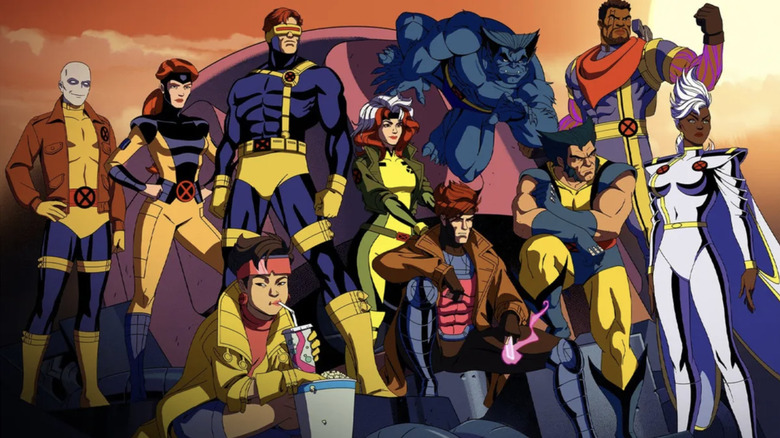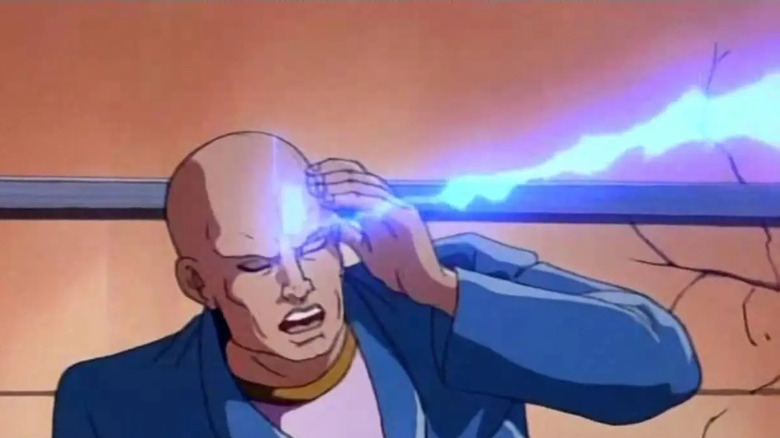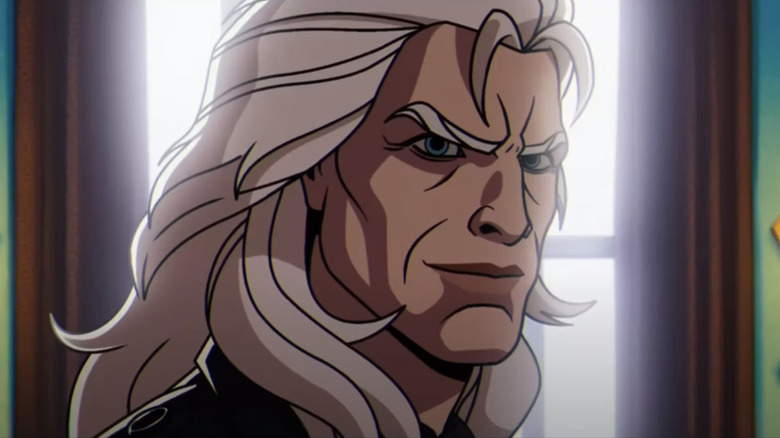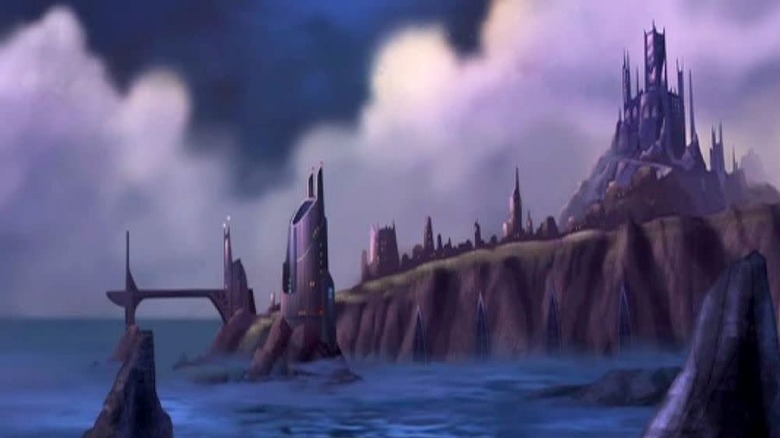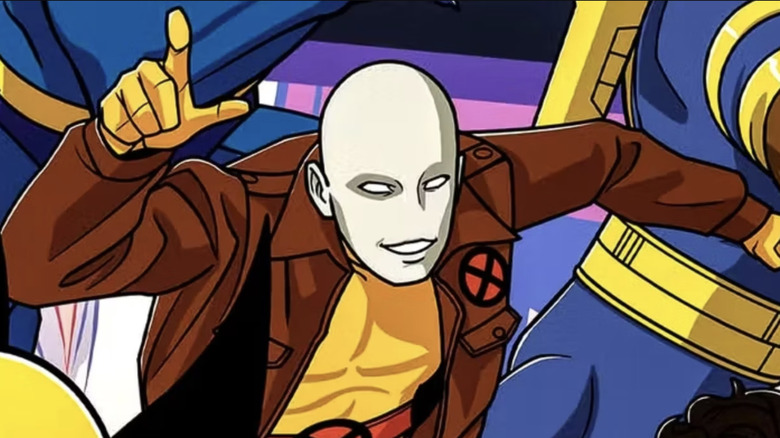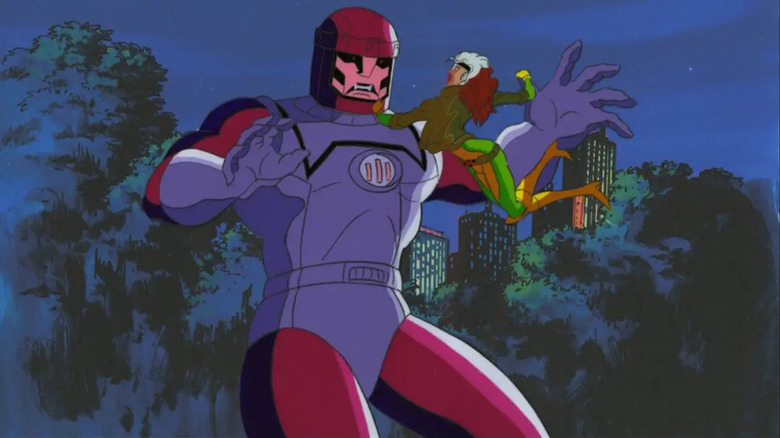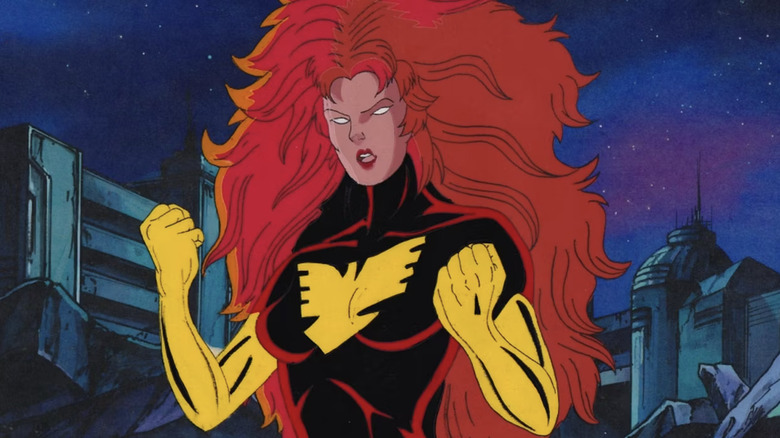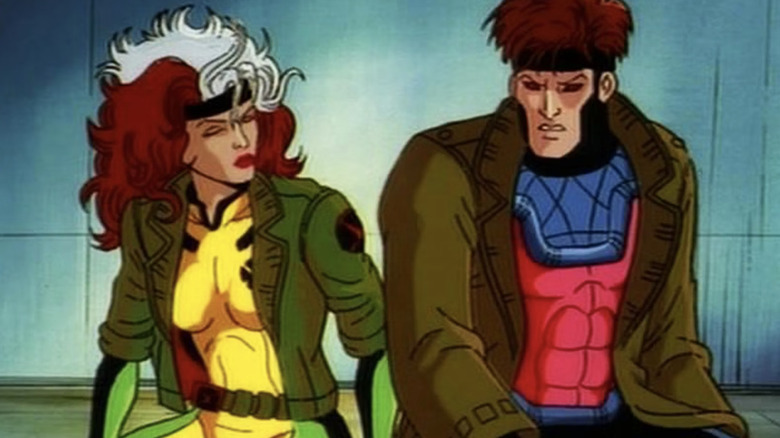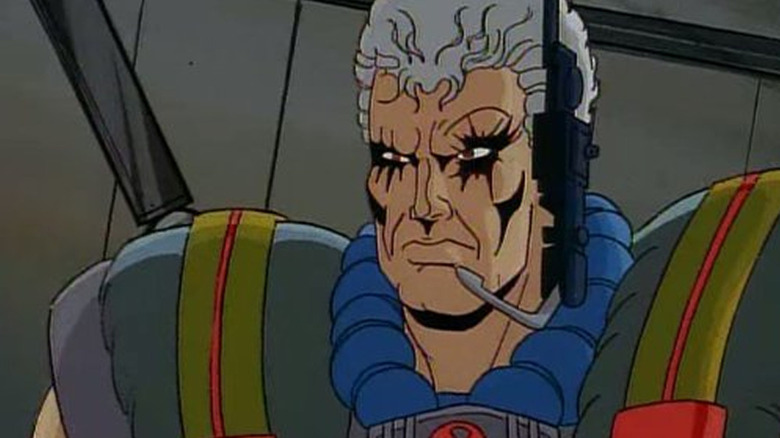Everything You Need To Remember About The Original Cartoon Before X-Men '97
Not to be one of those insufferable millennials who cries out "Only '90s kids remember," but hot dog do only '90s kids remember the glory of watching "X-Men: The Animated Series," aka the best animated Marvel superhero show of all time. The '90s was a bit of a wasteland of quality superhero offerings in live-action, but animated television was absolutely thriving. "X-Men: The Animated Series" helped turn a group of marvelous mutants into fast-favorites for a new generation, and set the groundwork for what many view as the definitive portrayals of many of the characters. And because everything old is new again, a continuation series, "X-Men '97," is coming our way to Disney+. The series is thankfully not a part of the Marvel Cinematic Universe, meaning it is picking up where the canon of the series finale left off in 1997 with "Graduation Day."
We already did the legwork of going beat by beat through the "X-Men '97" trailer to find any Easter eggs that might indicate where the series is headed, as well as dig through interviews with the show's creative team to gather any additional information that might be of service. So let us be your guide to prepare for "X-Men '97," or as the show would say ... previously, on "X-Men."
What happened to Professor Xavier?
As is shown in the trailer for "X-Men '97," Professor Charles Xavier was last seen in this animated world saying goodbye to his team. If you didn't watch the original series, this might seem shocking considering how prominent Professor X has been in live-action films (as portrayed by Patrick Stewart and James McAvoy) and even Harry Lloyd's iteration on the TV show "Legion." Alas, in the final episode of the "X-Men" animated series, the villainous government liaison Henry Peter Gyrich used an energy disruptor device against the Professor during a speech at the United Nations. The disruptor made the Professor's telepathic powers go into overdrive, effectively outing him as a mutant to the entire world. This only added to the already sky-high tensions between humans and mutants, but tragically, the overload also did serious psychic damage to the Professor. He slowly begins to die, and there's no cure on Earth.
Cyclops, Jean Grey, and Wolverine meet up with Magneto to see if there's anything that can be done and come to the conclusion that the only technology that might save him is at the Shi'ar Empire, an intergalactic empire that rules over hundreds of worlds. Magneto reaches out to Empress Lilandra, who confirms that Charles can be saved, but he would need to stay at the Shi'ar Throneworld. Professor X delivers an emotional farewell to his team, leaving with the Empress for her planet and effectively "dying" on Earth.
What was Magneto doing?
Magneto is one of the most fascinating figures in all of X-Men because he's typically presented as the archenemy of the X-Men team but often aligns with them if there's a greater threat to all mutants. He waffles between being an anti-hero and an anti-villain but is willing to protect mutants from oppressive humans at any cost. He's a survivor of the Holocaust, after all. Never again means never again. As is typically the case with all incarnations of Magneto, the vengeful Magnet Daddy was prepping for a humans vs. mutants civil war. He has taken it upon himself to lead the angry mutants, but when he hears about Charles Xavier's condition, he softens a bit.
Lest we forget, Magneto and Professor X go way, way back as friends, and their relationship often alters their behavior. In this instance, Magneto has amassed an army of mutants in Genosha in preparation for war, but he's willing to give it all up to save Charles by connecting him with Empress Lilandra. Magneto agrees to help, and it's implied at the end of the "Graduation Day" finale that he would take a less punitive approach to fighting for mutant rights, and a more nuanced and diplomatic approach like that of Charles Xavier. In the trailer for "X-Men '97," Magneto reveals that in Professor X's will, he has left the school to be run by Magneto, much to the chagrin of Cyclops (who fancies himself the one true successor).
Wait, what is Genosha?
Genosha is a nation on an island in the Indian Ocean south of Madagascar that was promoted as a safe haven for mutants. It was a land where mutants would not have to worry about the oppression of humans, and could use their powers freely without judgment. It was also a total sham, a way for human villains like Bolivar Trask, Cameron Hodge, Henry Peter Gyrich, and the Leader who used the island as a way to enslave mutants. They deployed Sentinels to kidnap them all and force them into labor. The group even captured Gambit, Storm, and Jubilee, but Gambit eventually escaped and linked up with Cable to free the mutants. Magneto and his Acolytes eventually went to Genosha to help free any others who were captured before subsequently taking over the country and turning Genosha into a sincere safe space for mutants, which is how it remains leading into "X-Men '97."
Bishop the time traveler officially joined the team
During the original run of "X-Men: The Animated Series," the time-traveling mutant known as Bishop showed up like a superhero terminator with the intent to kill Gambit, believing him to be responsible for the future assassination of Senator Robert Kelly (which would lead to the Sentinels taking over, giving rise to a pretty dystopian future). When Bishop first arrives back in the X-Men's time, he suffers from amnesia and even thinks he's supposed to kill all of the X-Men before realizing his only target is Gambit. However, the team eventually goes to the time and place of the supposed assassination and realizes that it was not Gambit who assassinated the senator, but Mystique in disguise as Gambit.
The team prevents the assassination, which allows Bishop to return to his own timeline. Unfortunately, upon returning, he sees that his world is still in chaos, meaning a different incident took place as a result of the foiled assassination, requiring Bishop to go back in time once again. This time, he has to stop a virus made by Apocalypse (the mutant character, not the live-action movie of the same name). To add another layer to it, the mutant Cable showed up from an even more distant timeline than Bishop's to stop him because Bishop's actions would erase Cable's timeline. (Look, it makes a lot more sense when you're watching the show rather than reading a synopsis online but I am trying my best!) Eventually, Cable ends up using Wolverine's healing powers to create antibodies to fight off the virus, restoring both timelines.
Bishop also has a sister named Shard who travels with him sometimes, and he's also traveled through time with alternate versions of other X-Men from other alternate timelines. You know, multiverse stuff! However, it was confirmed at San Diego Comic-Con 2023 that both Bishop and Morph will officially join the team for "X-Men '97." Speaking of...
Morph is back!
Once described by Wolverine as the only one who could ever make him laugh, Morph is back, and they've got a whole new look, baby! In the original series, Morph was a muscular dude with dark hair but is now a bit slimmer and has taken on a pale, featureless face and a bald head. They've got the power to shapeshift, so taking different forms is part of the charm, but the "default" setting to Morph is totally different from the first series. This was a decision made by "X-Men '97" creator Beau DeMayo (who was fired a week before the series premiere) to reflect Morph as a genderfluid character voiced by J. P. Karliak.
The look is inspired by their presentation in the 2001 X-Men comic book series "Exiles." So while this design didn't canonically appear until four years after "X-Men '97," it's a better representation of this version of the character. In the original animated series, it seemed as if Morph was killed during their first run-in with the Sentinels. The death was a major source of personal strife between Wolverine and Cyclops, as the latter made the call to leave Morph (and Beast) behind when they retreated from the battle. Morph was later revived and brainwashed by Mister Sinister in season 2 but eventually broke free of his power. It's pretty safe to assume that this storyline will be acknowledged in some way in "X-Men '97," so don't be surprised if Morph suddenly starts talking about their time working for the baddies.
What happened with the Sentinels?
When fans got their first look at "X-Men '97" at San Diego Comic-Con, the footage shown focused on the Sentinels, aka the artificially intelligent robots designed to hunt and destroy mutants. The Sentinels are some of the most formidable foes of the X-Men, because they never fully go away. They can be destroyed, but new ones can be built in their place with advancing technology, making them a constant threat. This current crop of Sentinels is the brainchild of Dr. Bolivar Trask, a human scientist and robotics expert who views the mutants as a threat to humanity. Knowing humans can't compete with the powers of X-Men, these robotic kaiju are meant to provide stopping power to capture and eliminate mutants despite their advanced abilities. The X-Men never really put a stop to the Sentinels, so they're definitely going to have to face off with these mecha monsters sooner rather than later.
Jean Grey and the Dark Phoenix
Jean Grey is one of the most fascinating characters of all the X-Men, and her Dark Phoenix arc is considered one of the best stories in the entire canon. In the original run of "The Animated Series," the entire third season centers around the cosmic force known as the Phoenix, which merges with Jean Grey and turns her into the Dark Phoenix. This is an extremely dangerous version of Jean Grey, with all of the powers but none of the moral compass. This season is also where we see the Shi'ar Empire and Empress Lilandra, who works with Gladiator in an attempt to stop the Dark Phoenix.
The X-Men try to find a way to expel the Phoenix Force from Jean without killing her, while the Shi'ar wants her dead. Professor Xavier proposes a Trial by Combat for the custody of Jean/Dark Phoenix's body on the Blue Area of the Moon. Eventually, the fight comes down between the Shi'ar Empire guard and Jean and Cyclops. After Cyclops is attacked, it's enough to push Jean over the edge and the Dark Phoenix persona comes back out to attack. The Guard unloads on her, which weakens the Phoenix and allows Jean to take over. Jean uses her telekinesis to make Lilandra's guns fire on her, effectively killing her. But the Phoenix Force claims that if all of the X-Men sacrifice a small bit of their own life force, Jean can be revived. The plan works and she is saved, the Phoenix flying off into space and Jean returning to normal.
Don't forget about the romance!
Something else "X-Men: The Animated Series" really leaned into during its time was not just superhero hijinks, but also the interpersonal lives and relationships between the mutants. Namely, their romantic relationships. Gambit and Rogue's relationship is considered by many to be the best ever presented in a superhero adaptation. They have palpable chemistry and exquisite "will-they/won't-they" banter because the pair are practically fueled by their constant flirting and teasing. They don't follow a traditional love story, but they are, as the kids say, goals.
Meanwhile, there's also the messy love triangle of Wolverine, Jean Grey, and Cyclops. Scott and Jean are married (and Jean is pregnant!) but Wolverine/Logan has been in love with her forever. Meanwhile, Jean loves Scott more than anything, but she deeply cares about Logan and is very attracted to him. This means there is an absurd amount of tension surrounding them all, and the best part is that the rest of the X-Men are all fully aware of the unspoken dynamics. Honestly, at this point, it feels like the trio is already emotionally in what is known as a "V Throuple," with Jean acting as the hinge with her two beefy boyfriends. Just be adults and try out polyamory or something, it's the '90s!
Who is Cable, again?
I've mentioned Cable throughout this article but in case you need a refresher on the character, I'm happy to provide it. Cable aka Nathan Summer is being voiced by Chris Potter, who originally voiced Gambit in the original series. Creator Beau DeMayo explained to Entertainment Weekly that while many of the voice changes on the new series are a result of more authentic representation (for example, Holly Chou now voices Jubilee so she is voiced by an actual Asian-American person), there are also thematic reasonings behind recasting. He even highlighted Cable as one of the most prominent thematic recast decisions. Cable is a time-displaced mutant, and is the son of Cyclops in a future timeline. "It was really [about] how do we make sure that the audience knows that this is a weird relationship where the father is younger than the son and making sure the vocal qualities tell that story when they're talking to each other," DeMayo explained. So not only is Cable a time traveler like Bishop, but he's also simultaneously younger and older than his own father.
His presence is also fascinating because the trailers show Jean Grey as pregnant, but we don't know which baby she is pregnant with. As previously stated, Jean dies a lot and has been cloned, and one of her clones has also been pregnant. So, looking at the comic lore, we can wonder if Jean is pregnant with her and Scott Summers/Cyclops' daughter Rachel from the alternate "Days of Future Past" timeline ... or is this the clone of Jean Grey pregnant with Cable? Is Cable going to go back in time and see himself as a baby?! Just imagine the cursed multiverse bedlam that could come from this?!
"X-Men '97" premieres its first two episodes on Disney+ on March 20, 2024. Subsequent episodes will be released weekly on Wednesdays.
